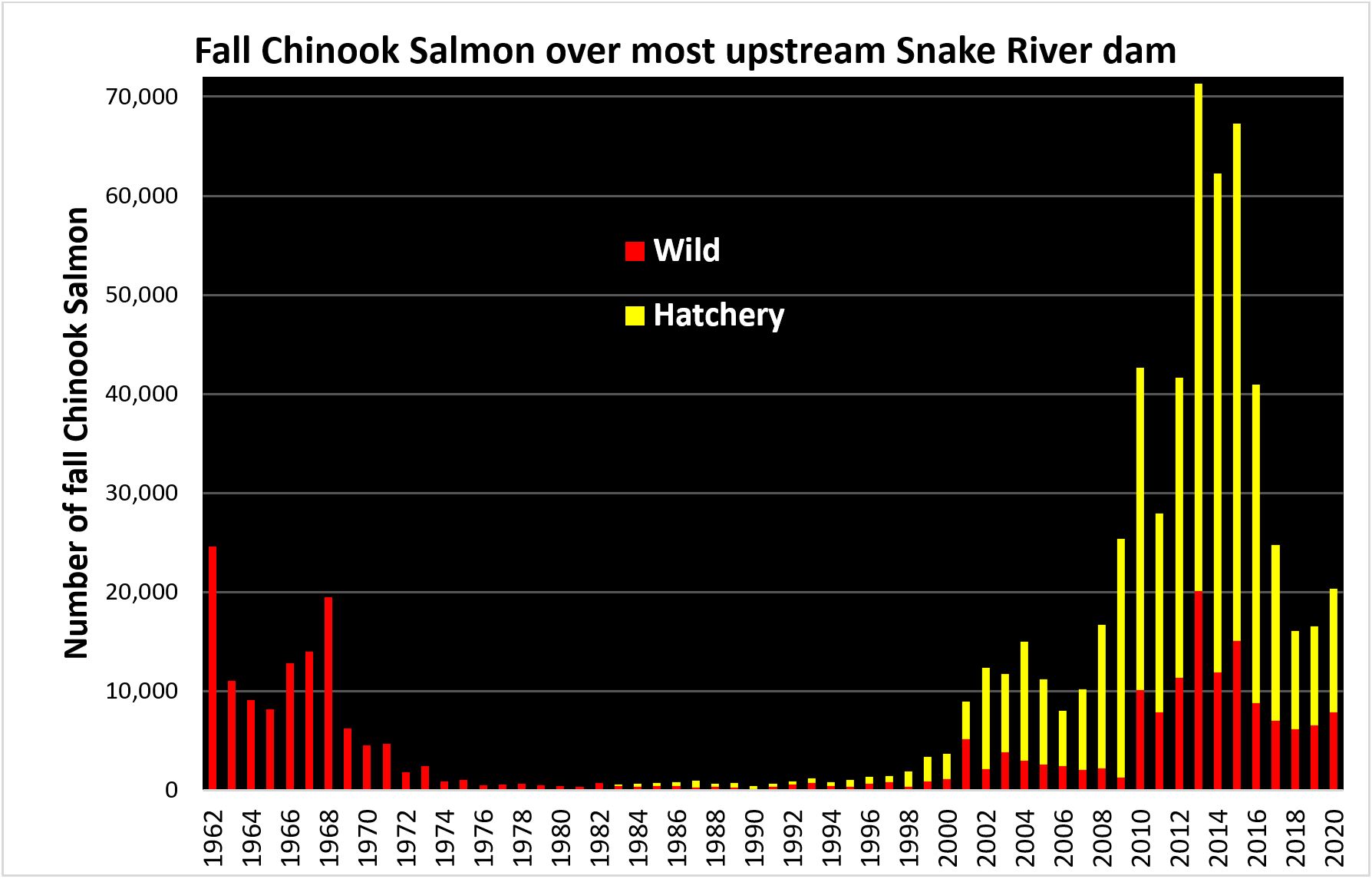Fall Chinook Salmon Update 2021
by Marika Dobos and Joe DuPont

Fall Chinook Salmon are trickling in at Lower Granite Dam. This means anglers will soon have an opportunity to catch these big guys. The current estimate for this year’s fall Chinook Salmon return to Lower Granite Dam is 24,710 adults and about 10,000 jacks. These estimates are close to what returned last year in 2020.
Idaho’s Fish and Game Commission set the fall Chinook Salmon season last July using this forecast. There are some differences this year that you will want to be aware of. Roughly, the regulations are as follows:
• Season starts August 18, 2021
• The fishery will occur in the Snake River, lower Salmon River, and much of the Clearwater basin
• The daily limits are three (3) adult fish (adipose clipped or unclipped)
• Fishing will be allowed seven days a week in all areas that are open
Be sure to visit the IDFG website for all the details on the 2021 fall Chinook Salmon seasons and limits (fall Chinook regulations).
In recent years, many anglers have asked about the fall Chinook Salmon broodstock trapping program at Lower Granite Dam (LGD). For this reason, we decided to provide information about this program that answers many of the questions we commonly get.
The fall Chinook Salmon hatchery program has been instrumental in the increase of returning fall Chinook Salmon seen over the years. Since the first dam was completed in the lower Snake River, window counts of fall Chinook declined from about 25,000 adult fish in 1962 to a low of 340 fish in 1982 (see Figure below). Because of these alarmingly low returns, Snake River fall Chinook Salmon were listed as threatened under the Endangered Species Act in 1992. As part of the recovery plan, two hatcheries, Lyons Ferry Fish Hatchery (est. 1984) and Nez Perce Tribal Hatchery (est. 2002) were constructed to develop a large-scale production program for fall Chinook Salmon managed by the Washington Department of Fish and Wildlife and Nez Perce Tribe.

Because fall Chinook Salmon tend to spawn in larger main stem rivers such as the Snake and Clearwater rivers, it was much easier to trap fish for the hatchery program from LGD’s fish ladder. Collections of fall Chinook Salmon at LGD now begins in early to mid-August and continues until November or when program goals are met. There are three primary goals managers try to achieve when collecting broodstock for this program.
1. Collect close to 4,000 total fall Chinook Salmon, half of which are females
70% will be sent to Lyons Ferry Fish Hatchery and 30% to the Nez Perce Tribal Fish Hatchery
2. Collect a high proportion of older fish to maintain returns of larger adults
3. Ensure at least 30% of the total broodstock is of natural-origin
In the fall, not only are fall Chinook Salmon ascending LGD but so are steelhead. Because steelhead are also listed as threatened under the Endangered Species Act, a balance needs to be reached so that the fall Chinook Salmon hatchery program can reach its brood-stock goals while minimizing handling of wild returning steelhead. Program managers have learned that more natural-origin and older aged fall Chinook Salmon returned early (August through early September) in the run. Interestingly, during this time, there are also fewer steelhead crossing LGD because their run peaks a little later than for fall Chinook Salmon (see Figure below). To help ensure fall Chinook Salmon brood-stock goals are met and wild steelhead are handled less frequently, program managers trap the early part of the fall season at a higher rate at LGD. This allows the trap rate to be lowered once steelhead start coming over in larger numbers.

If you keep a close eye on counts of fall Chinook Salmon at LGD, realize that the window counts occur before fish are trapped and removed for broodstock. This means that potentially fewer fall Chinook Salmon are actually passing over LGD than the window counts indicate. The tap rate has varied over the years, but from August 18 through the first week of September, typically 70-80% of the run is trapped. That means a lot of fall Chinook Salmon are being removed for hatchery broodstock at that time. Once steelhead show up in better numbers and/or fall Chinook Salmon brood-stock goals are being met, the trap rate typically drops below 20%. The marked improvement in fall Chinook Salmon returns from what we once saw in the 1990s is a testament to the success of this program. So don’t get too discouraged when the hours spent on the river during the early season are not very fruitful. After all, when the bulk of the run arrives, trap rates will drop and fall Chinook Salmon will pour into Idaho.

